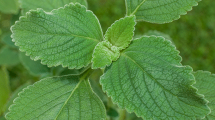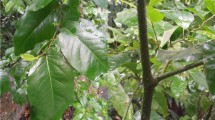Abstract
Mosquitoes transmit serious pathogens and parasites to humans and animals, including malaria, dengue, Japanese encephalitis and filariasis. The extensive use of chemical pesticides leads to the development of resistance in mosquito vector populations and serious non-target effects on human health and the environment. Myrtaceae plants can be a useful reservoir of natural products effective against Culicidae young instars. In this research, we evaluated the mosquitocidal potential of the essential oil (EO) from Syzygium zeylanicum leaves against larvae of three mosquitoes of medical and veterinary importance, the malaria vector Anopheles subpictus, the dengue vector Aedes albopictus, and the Japanese encephalitis vector Culex tritaeniorhynchus. The chemical composition of the EO was analyzed by gas chromatography–mass spectroscopy. GC-MS revealed that the S. zeylanicum EO contained at least 18 compounds. The major chemical components were α-humulene (37.8.5 %) and β-elemene (10.7 %). The EO had a significant toxic effect against early third-stage larvae of An. subpictus, Ae. albopictus, and Cx. tritaeniorhynchus, with LC50 values of 83.11, 90.45, and 97.96 μg/ml, respectively. The two major constituents extracted from the S. zeylanicum EO were tested individually for acute toxicity against larvae of the three mosquito vectors. α-Humulene and β-elemene appeared highly effective against An. subpictus (LC50 = 6.19 and 10.26 μg/ml, respectively), followed by Ae. albopictus (LC50 = 6.86 and 11.15 μg/ml) and Cx. tritaeniorhynchus (LC50 = 7.39 and 12.05 μg/ml). Furthermore, the EO and its major components was safe towards the non-target fish Gambusia affinis; LC50 values were 20374.26, 1024.95, and 2073.18 μg/ml, respectively for EO, α-humulene and β-elemene. Overall, this study highlighted that the acute toxicity of S. zeylanicum EO towards mosquito larvae was mainly due to the presence of α-humulene and β-elemene. Furthermore, we pointed out the concrete possibility to exploit these two compounds from S. zeylanicum EO as highly effective larvicides against young instars of An. subpictus, Ae. albopictus, and Cx. tritaeniorhynchus, with little effect on non-target organisms.

Similar content being viewed by others
References
Amer A, Mehlhorn H (2006a) Repellency effect of forty-one essential oils against Aedes, Anopheles and Culex mosquitoes. Parasitol Res 99:478–490
Amer A, Mehlhorn H (2006b) The sensilla of Aedes and Anopheles mosquitoes and their importance in repellency. Parasitol Res 99:491–499
Amer A, Mehlhorn H (2006c) Larvicidal effects of various essential oils against Aedes, Anopheles, and Culex larvae (Diptera, Culicidae). Parasitol Res 99:466–472
Amer A, Mehlhorn H (2006d) Persistency of larvicidal effects of plant oil extracts under different storage conditions. Parasitol Res 99:473–477
Bekele J, Hassanali A (2001) Blend effects in the toxicity of the essential oil constituents of Ocimum kilimandscharicum and Ocimum kenyense (Labiateae) on two post-harvest insect pests. Phytochemistry 57:385–391
Benelli G (2015a) Research in mosquito control: current challenges for a brighter future. Parasitol Res 114:2801–2805
Benelli G (2015b) Plant-borne ovicides in the fight against mosquito vectors of medical and veterinary importance: a systematic review. Parasitol Res 114:3201–3212
Benelli G (2016a) Plant-mediated biosynthesis of nanoparticles as an emerging tool against mosquitoes of medical and veterinary importance: a review. Parasitol Res 115:23–34
Benelli G (2016b) Plant-mediated synthesis of nanoparticles: a newer and safer tool against mosquito-borne diseases? Asia Pafic J Trop Biomed. doi:10.1016/j.apjtb.2015.10.015
Benelli G, Mehlhorn H (2016) Declining malaria, rising dengue and Zika virus: insights for mosquito vector control. Parasitol Res. doi:10.1007/s00436-016-4971-z
Benelli G, Bedini S, Cosci F, Cioni PL, Amira S, Benchikh F, Laouer H, Di Giuseppe G, Conti B (2015a) Mediterranean essential oils as effective weapons against the West Nile vector Culex pipiens and the Echinostoma intermediate host Physella acuta: what happens around? An acute toxicity survey on non-target mayflies. Parasitol Res 114:1011–1021
Benelli G, Bedini S, Cosci F, Toniolo C, Conti B, Nicoletti M (2015b) Larvicidal and ovideterrent properties of neem oil and fractions against the filariasis vector Aedes albopictus (Diptera: Culicidae): a bioactivity survey across production sites. Parasitol Res 114:227–236
Benelli G, Murugan K, Panneerselvam C, Madhiyazhagan P, Conti B, Nicoletti M (2015c) Old ingredients for a new recipe? Neem cake, a low-cost botanical by-product in the fight against mosquito-borne diseases. Parasitol Res 114:391–397
Chandramohan B, Murugan K, Panneerselvam C, Madhiyazhagan P, Chandirasekar R, Dinesh D, Mahesh Kumar P, Kovendan K, Suresh U, Subramaniam J, Rajaganesh R, Aziz AT, Syuhei B, Saleh Alsalhi M, Devanesan S, Nicoletti M, Wei H, Benelli G (2016) Characterization and mosquitocidal potential of neem cake-synthesized silver nanoparticles: genotoxicity and impact on predation efficiency of mosquito natural enemies. Parasitol Res 115:1015–1025
Cheng S, Liu JY, Tsai KH, Chen WJ, Chang ST (2004) Chemical composition and mosquito larvicidal activity of essential oils from leaves of different Cinnamomum osmophloeum provenances. J Agric Food Chem 52:4395–4400
Cheng SS, Huang CG, Chen YJ, Yu JJ, Chen WJ, Chang ST (2009) Chemical compositions and larvicidal activities of leaf essential oils from two Eucalyptus species. Bioresour Technol 100:452–456
Conti B, Flamini G, Cioni PL, Ceccarini L, Macchia M, Benelli G (2014) Mosquitocidal essential oils: are they safe against non-target aquatic organisms? Parasitol Res 113:251–259
Costa JGM, Rodrigues FFG, Angélico EC, Silva I, Mota ML, Santos NKA, Cardoso ALH, Lemos TLG (2005) Chemical–biological study of the essential oils of Hyptis martiusii, Lippia sidoides and Syzigium aromaticum against larvae of Aedes aegypti and Culex quinquefasciatus. Braz J Pharmacogenomics 15:304–309
Deo PG, Hasan SB, Majumdar SK (1988) Toxicity and suitability of some insecticides for household use. Integr Pest Control 30:118–129
Finney DJ (1971) Probit analysis. Cambridge University Press, London, pp 68–72
Fischer LG, Santos D, Serafin C, Malheiros A, Delle Monache F, Delle Monache G, Cechinel Filho V, de Souza MM (2008) Further antinociceptive properties of extracts and phenolic compounds from Plinia glomerata (Myrtaceae) leaves. Biol Pharm Bull 31:235–239
Govindarajan M (2010) Chemical composition and larvicidal activity of leaf essential oil from Clausena anisata (Willd.) Hook. f. ex Benth (Rutaceae) against three mosquito species. Asia Pacif J Trop Med 3:874–877
Govindarajan M, Benelli G (2016) Facile biosynthesis of silver nanoparticles using Barleria cristata: mosquitocidal potential and biotoxicity on three non-target aquatic organisms. Parasitol Res. doi:10.1007/s00436-015-4817-0
Govindarajan M, Sivakumar R, Rajeswari M, Yogalakshmi K (2012) Chemical composition and larvicidal activity of essential oil from Mentha spicata (Linn.) against three mosquito species. Parasitol Res 110:2023–2032
Govindarajan M, Rajeswary M, Hoti SL, Bhattacharyya A, Benelli G (2016a) Eugenol, α-pinene and β-caryophyllene from Plectranthus barbatus essential oil as eco-friendly larvicides against malaria, dengue and Japanese encephalitis mosquito vectors. Parasitol Res 115:807–815
Govindarajan M, Rajeswary M, Hoti SL, Benelli G (2016b) Larvicidal potential of carvacrol and terpinen-4-ol from the essential oil of Origanum vulgare (Lamiaceae) against Anopheles stephensi, Anopheles subpictus, Culex quinquefasciatus and Culex tritaeniorhynchus (Diptera: Culicidae). Res Vet Sci 104:77–82
Govindarajan M, Rajeswary M, Veerakumar K, Muthukumaran U, Hoti SL, Mehlhorn H, Barnard DR, Benelli G (2016c) Novel synthesis of silver nanoparticles using Bauhinia variegata: a recent eco-friendly approach for mosquito control. Parasitol Res 115:723–733
Hemingway J, Ranson H (2000) Insecticide resistance in insect vectors of human disease. Annu Rev Entomol 45:371–391
Kim SI, Lee DW (2014) Toxicity of basil and orange essential oils and their components against two coleopteran stored products insect pests. J Asia Pac Entomol 17:13–17
Kuskoski EM, Vega JM, Rios JJ, Fett R, Troncoso AM, Asuero AG (2003) Characterization of anthocyanins from the fruits of baguaçu (Eugenia umbelliflora Berg). J Agric Food Chem 51:5450–5454
Lis-Balchin M, Hart SL, Deans SG (2000) Pharmacological and antimicrobial studies on different tea-tree oils (Melaleuca alternifolia, Leptospermum scoparium or Manuka and Kunzea ericoides or Kanuka), originating in Australia and New Zealand. Phytother Res 14:623–629
Mabberly DJ (1997) The plant book. A portable dictionary of the vascular plants, 2nd edn. Cambridge University Press, Cambridge
Mehlhorn H, Al-Rasheid KA, Al-Quraishy S, Abdel-Ghaffar F (2012) Research and increase of expertise in arachno-entomology are urgently needed. Parasitol Res 110:259–265
Mittal PK, Subbarao SK (2003) Prospects of using herbal products in mosquito control. ICMR Bull 33:1–10
Murugan K, Benelli G, Panneerselvam C, Subramaniam J, Jeyalalitha T, Dinesh D, Nicoletti M, Hwang JS, Suresh U, Madhiyazhagan P (2015a) Cymbopogon citratus-synthesized gold nanoparticles boost the predation efficiency of copepod Mesocyclops aspericornis against malaria and dengue mosquitoes. Exp Parasitol 153:129–138
Murugan K, Priyanka V, Dinesh D, Madhiyazhagan P, Panneerselvam C, Subramaniam J, Suresh U, Chandramohan B, Roni M, Nicoletti M, Alarfaj AA, Higuchi A, Munusamy MA, Khater HF, Messing RH, Benelli G (2015b) Enhanced predation by Asian bullfrog tadpoles, Hoplobatrachus tigerinus, against the dengue vector Aedes aegypti in an aquatic environment treated with mosquitocidal nanoparticles. Parasitol Res 114:3601–3610
Naqqash MN, Gökçe A, Bakhsh A, Salim M (2016) Insecticide resistance and its molecular basis in urban insect pests. Parasitol Res. doi:10.1007/s00436-015-4898-9
Nuengchamnong N, Ingkaninan K (2009) On-line characterization of phenolic antioxidants in fruit wines from family Myrtaceae by liquid chromatography combined with electrospray ionization tandem mass spectrometry and radical scavenging detection. Food Sci Technol 42:297–302
Park HM, Kim J, Chang KS, Kim BS, Yang YJ, Kim GH, Shin SC, Park IK (2011) Larvicidal activity of Myrtaceae essential oils and their components against Aedes aegypti, acute toxicity on Daphnia magna, and aqueous residue. J Med Entomol 48:405–410
Pavela R (2015a) Essential oils for the development of eco-friendly mosquito larvicides: a review. Ind Crop Prod 76:174–187
Pavela R (2015b) Acute toxicity and synergistic and antagonistic effects of the aromatic compounds of some essential oils against Culex quinquefasciatus Say larvae. Parasitol Res 114:3835–3853
Pavela R, Kaffkova K, Kumsta M (2014) Chemical composition and larvicidal activity of essential oils from different Mentha L. and Pulegium species against Culex quinquefasciatus Say (Diptera: Culicidae). Plant Prot Sci 50:36–42
Pohilt AM, Rezende AR, Lopes Baldin EL, Lopes NP, de Andrade Neto VF (2011) Plant extracts, isolated phytochemicals, and plant-derived agents which are lethal to arthropod vectors of human tropical diseases—a review. Planta Med 77:618–630
Pullaiah T (2006) Encyclopedia of world medicinal plants. Regency, Pune, pp 1895–1898
Sivagnaname N, Kalyanasundaram M (2004) Laboratory evaluation of methanolic extract of Atlantia monophylla (Family: Rutaceae) against immature stages of mosquitoes and non-target organisms. Mem Inst Oswaldo Cruz 99:115–118
Stefanello MEA, Pascoal ACRF, Salvador MJ (2011) Essential oils from neotropical Myrtaceae: chemical diversity and biological properties. Chem Biodivers 8:73–94
Tabashnik BE (1994) Evolution of resistance to Bacillus thuringiensis. Annu Rev Entomol 39:47–79
WHO (2005) Guidelines for laboratory and field testing of mosquito larvicides. Communicable disease control, prevention and eradication, WHO pesticide evaluation scheme. WHO, Geneva, WHO/CDS/WHOPES/GCDPP/1.3
Acknowledgments
H. Mehlhorn and two anonymous reviewers improved an earlier version of the manuscript. The authors would like to thank the Head of the Department of Zoology, Annamalai University, for the laboratory facilities provided. We also acknowledge the cooperation of staff members of the VCRC (ICMR), Pondicherry.
Author information
Authors and Affiliations
Corresponding authors
Ethics declarations
All applicable international and national guidelines for the care and use of animals were followed. All procedures performed in studies involving animals were in accordance with the ethical standards of the institution or practice at which the studies were conducted.
Conflict of interest
The authors declare no conflicts of interest. G. Benelli is an Editorial Board Member of Parasitology Research. This does not alter the authors’ adherence to all the Parasitology Research policies on sharing data and materials.
Rights and permissions
About this article
Cite this article
Govindarajan, M., Benelli, G. α-Humulene and β-elemene from Syzygium zeylanicum (Myrtaceae) essential oil: highly effective and eco-friendly larvicides against Anopheles subpictus, Aedes albopictus, and Culex tritaeniorhynchus (Diptera: Culicidae). Parasitol Res 115, 2771–2778 (2016). https://doi.org/10.1007/s00436-016-5025-2
Received:
Accepted:
Published:
Issue Date:
DOI: https://doi.org/10.1007/s00436-016-5025-2




